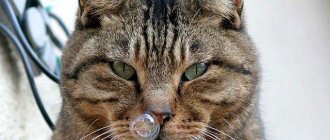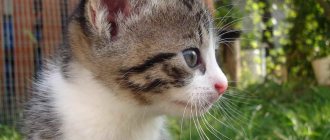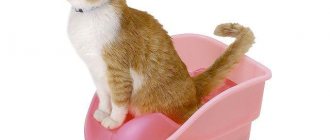The consequences of even the most harmless runny nose for a pet can be very serious. Cats' sense of smell is much more developed than that of humans, and it is inextricably linked with nutrition. An animal that has lost its sense of smell practically stops eating because it cannot smell the food. Due to prolonged fasting, problems with the digestive organs arise. This is just one of the reasons why it is necessary to fight a runny nose in cats.
Let's figure out what diseases rhinitis can be a symptom of and in what cases it can be cured at home.
Rhinitis in cats
Inflammation of the nasal mucosa is scientifically called rhinitis. We are not talking about a disease, but rather about a symptom that can accompany various diseases of infectious and non-infectious etiology.
A runny nose in a cat is easy to recognize even for a person ignorant of veterinary medicine. Characteristic manifestations of rhinitis are nasal discharge and frequent sneezing. When a cat owner observes such symptoms, he assumes that the pet has caught a cold. However, there are many causes of rhinitis, and many of them are quite serious.
It is imperative to diagnose and treat a runny nose in a kitten or an adult animal, otherwise it will become chronic. In addition, nasal discharge may indicate serious local and systemic pathologies.
Cat snot differs in color. Mucus can be transparent, light yellow, green or with a brown tint. The color may suggest a bacterial infection, the presence of a foreign object or tumor in the nasal passage.
Types of rhinitis
Runny nose in cats can be acute or chronic. In the first case, snot appears immediately after an infection enters the body that affects the upper respiratory tract. In this case, inflammation can affect not only the nasal mucosa, but also the paranasal sinuses and trachea.
Chronic runny nose develops gradually in cats and lasts a long time - from 2 weeks to several months. Symptoms of rhinitis either fade or reappear, but the snot never goes away. In most cases, chronic runny nose is the result of an untreated infectious disease or the appearance of tumors in the nose.
Nose injuries
The nasal planum is an organ that provides the domestic predator with a significant amount of information about the surrounding world. When getting acquainted with something new, a cat carefully sniffs the object. She does the same with new pets or guests. By touching the owner’s hands and shoes and his things with his nose, the animal “reads information” about where the person has been, with whom he has been in contact, and what he has touched.
By sniffing food, the little hunter determines not only its freshness and edibility, but also its temperature. Injuries to the nasal planum are possible both in a pet that is allowed outside and in a couch potato.
A sore on a cat’s nose can appear after a fight with relatives, an unsuccessful jump from a height, or sniffing thorny indoor plants. Pets that live in the same house from a young age often do not perceive each other as links in the food chain. They play, communicate with each other, and not always neatly.
In case of a minor injury or ulcer on the nose, the cat can be treated by lubricating the nasal planum with vegetable oil, such as sea buckthorn or olive. A little tea tree essential oil is first added to olive oil (2-3 drops per 1 tsp), which improves wound healing and helps suppress the activity of microorganisms (bacteria, viruses, fungi). Before the procedure, you can lightly wash the wound by touching it with a cotton pad soaked in a pale pink solution of potassium permanganate (potassium permanganate).
If there is no effect from home treatment within 3-5 days, a veterinarian will help cure the small predator. Perhaps an infection has joined the injury or there is an allergic reaction to something.
The main causes of a runny nose in a cat
Most often, snot in a cat appears due to a viral, bacterial or fungal infection. However, there are other causes of a runny nose:
- New growths in the nose - benign or malignant.
- Injury. A runny nose can develop when the upper palate is damaged. This happens when cats fall from a height and hit their face hard.
- Abscesses of teeth.
- Entry of a foreign body into the nasal passage.
- Allergies to chemicals or medications.
Viral infections
Viral agents provoke the rapid appearance of a runny nose. In cats, rhinitis occurs with calicivirus and herpes virus infection. Both diseases affect pets of different ages, but older animals, kittens and individuals with weakened immune systems are most susceptible to them.
Outbreaks of infections occur in autumn and spring. Cats become infected from sick animals or carriers of the virus through direct contact, as well as through aerogenic and nutritional routes.
The manifestations of viral diseases are largely similar:
- With herpes virus infection, runny nose, sneezing and fever are also observed. At the initial stage of the disease, the discharge from the nasal passages is serous, and then green snot appears. A sick cat's nose turns red, the gums and mucous membrane of the larynx swell. When examining the mouth, you can see a white coating on the tongue and the inner surface of the cheeks, as well as ulcers covered with crusts. When palpating the cat's neck, pain and anxiety are detected in the tracheal area.
- With calicivirus, a cat develops a runny nose, sneezing, red eyelids and watery eyes. First, mucus secretes from the nose, and it flows from two nasal passages. Later they become denser and change color to green. Then conjunctivitis develops. The cat's general condition is deteriorating - he loses his appetite, seems lethargic, and drowsy. Body temperature rises to 40.5 degrees. Ulcers appear on the mucous membranes of the mouth and on the nose, and an unpleasant odor is felt from the mouth. In some cases, cats experience diarrhea.
Bacterial and fungal infections
A runny nose can be caused not only by viral agents, but also by a bacterial or fungal infection. Prolonged snot in cats is caused by pathogenic bacteria - chlamydia, bordetella and mycoplasma. These microorganisms usually complicate the course of diseases caused by viral infections.
Sometimes the cause of a runny nose in cats is mycosis. A striking example of this is cryptococcus fungi, which affect the respiratory system, skin, eyes, and sometimes the brain. Infection occurs aerogenously - through inhalation of microorganisms.
Carriers of fungal infections are poultry, which excrete pathogens in their droppings. When a pet sniffs the ground, fungal spores enter the respiratory tract. Domestic cats can also get cryptococcosis if the owner brings the infection from the street on his shoes.
If this disease occurs in the nasal form, then it all starts with a runny nose. A little later, the pet sneezes, snorts, breathes heavily and coughs. Sometimes cryptococcosis is accompanied by damage to the eyes, and purulent exudate is released from them. If the cat is not treated, there is a risk of infection of the lining of the brain.
Aspergillosis is another disease whose symptom is a runny nose. Its causative agents are fungi of the genus Aspergillus. Infection occurs when a cat inhales spores of pathogens that are in the environment. Individuals with reduced immunity are most susceptible to this disease - those who have recently suffered viral infections or taken antibiotics.
- With sinonasal aspergillosis, serous or mucopurulent discharge can flow from one side or from both. In rare cases, in addition to a runny nose and sneezing, the animal may experience nosebleeds. A sick cat's breathing is difficult. Sometimes soft tissue protrudes from the nostrils and granulomas form.
- Sino-orbital aspergillosis is more severe - the fungus can affect the bones of the eye sockets. In this case, the sick cat develops unilateral exophthalmos, third eyelid prolapse or keratitis. In some animals, the central nervous system is affected, as evidenced by the appearance of neurological symptoms.
Neoplasms
Another cause of a runny nose is benign and malignant tumors in the nose.
Polyps
Nasopharyngeal polyps are common in cats and are one of the causes of nasopharyngeal diseases. They are formed due to a long-term inflammatory process, which can be caused by an infectious disease or allergy. Polyps grow gradually.
The severity of symptoms depends on the size of the tumor:
- the cat snores in her sleep;
- nasal breathing is difficult;
- the sense of smell partially or completely disappears;
- purulent snot flows;
- sometimes there is bleeding from the nasal passages;
- the cat sneezes often.
Attention! A runny nose, which is caused by the presence of a polyp, often has serious consequences. Due to the lack of smell, a sick cat loses its appetite and eats very little. This leads to exhaustion.
Malignant neoplasms
Common in cats:
- adenocarcinoma,
- lymphomas,
- sarcomas.
With cancer, a runny nose is of a different nature. Discharge appears on one or both sides. The snot is initially mucous, and later becomes purulent mixed with blood. Many cats experience swelling on their faces and their sinuses become deformed.
It is not possible to treat a runny nose caused by a malignant tumor at home. In this case, surgery and chemotherapy help.
Injuries and foreign bodies
Chronic runny nose occurs in a cat with a cleft palate. This pathology is the result of a strong blow due to a fall from a height. In this case, mucous or purulent exudate with food particles is released from both nostrils.
A runny nose in a cat also appears when the mucous membrane and soft tissues of the nasal passages are injured by a foreign body. The presence of a foreign object in the nasopharynx can be suspected if the cat is coughing, gagging, and the nostril feels hard and slightly swollen.
If the foreign body is not removed, clear discharge soon appears, then it changes color to greenish. Sometimes they contain blood. A runny nose is accompanied by sneezing, and breathing becomes difficult.
Other reasons
Less commonly, runny noses in cats occur due to allergies. The nasal mucosa becomes irritated when exposed to allergens - tobacco smoke, dust, pollen or chemicals. The cat often rubs its nose with its paw, sneezes and coughs. Partial or complete loss of smell is possible. With allergic rhinitis in cats, the discharge is clear and runny.
In kittens, a runny nose may be associated with an abnormality in the structure of the palate and nasal cavity. A striking example is the so-called cleft palate. This is a congenital pathology in which there is a hole between the palatine bones.
If such a defect is present, the kitten cannot normally suck mother's milk, since it enters the nasal cavity when swallowed.
Diseases of the teeth and gums can lead to a runny nose in a cat. When the root is inflamed, purulent snot usually flows from one side. In this case, swelling and redness are detected on the cat’s upper jaw.
Dermatological diseases
The cat's body is susceptible to autoimmune diseases. In such cases, the immune system attacks the body's own tissues where the target cells are located. Dermatoses of this type include:
- Pemphigus foliaceus. The intercellular epidermal tissue is affected, which leads to the appearance of pustular rashes on the face. May be accompanied by hyperthermia, lethargy, and refusal to eat. A biopsy of the affected areas is necessary.
- Common pemphigus. The epidermis stratifies with the formation of bubbles filled with liquid, which burst, turning into ulcers on the nose, lips and in the oral cavity. May be fatal. A histological examination of the damaged mucosa is required.
- Erythematous pemphigus. Most often, only the nose is affected. Accompanied by pigmentation disorders, rashes, ulceration of the nasal planum, bridge of the nose and bridge of the nose, and the formation of scabs.
- Pemphigus vegetans. A relatively mild form of dermatosis. Main symptoms: rash and blisters.
- Systemic lupus erythematosus. Skin manifestations are observed in the discoid form, involving the nose, ears, eyelids, lips. The process begins with changes in pigmentation and redness, then ulcers form. Systemic disorders include: damage to the hematopoietic system (anemia, decreased blood clotting), kidneys, joints, gastrointestinal tract, central nervous system. Tests for antinuclear antibodies and a biopsy of the epidermis are necessary.
- Vasculitis. The disease affects blood vessels, which leads to a deterioration in the blood supply to tissues and their subsequent death. Most often, the nose, lips, tip of the tail, ears, paw pads, and genitals are affected.
- Cold agglutinin disease. Reason: at low ambient temperatures, red blood cells interact with immunoglobulins. The same areas are damaged as with vasculitis. They acquire a bluish coloration, pigmentation is disrupted, and hair falls out. In severe cases, necrosis may occur.
If these symptoms appear, you should contact your veterinarian as soon as possible. He will prescribe the necessary tests, conduct an examination and make a diagnosis. Treatment of autoimmune diseases is a complex and lengthy process, including therapy with corticosteroids and immunosuppressants.
General and associated symptoms
Associated symptoms and treatment of a runny nose differ depending on the pathology that caused it. General manifestations of nasal discharge and sneezing may be accompanied by the following clinical signs:
- redness of the eyes;
- tearfulness;
- cough;
- ulcers on the oral mucosa;
- swelling and asymmetry of the muzzle;
- redness of the gums;
- sour eyes;
- protrusion of soft tissues from the nasal passages;
- snore;
- difficulty or noisy breathing;
- lack of appetite;
- weight loss;
- temperature increase;
- unpleasant odor from the mouth;
- lethargy, apathy.
It is important to carefully monitor your cat's condition when he has a runny nose and record any changes. This data will help the veterinarian find the true cause of rhinitis and prescribe the correct treatment.
Causes
Pus from the nose
Diseases in which pus is discharged from the nose are divided into contagious and non-contagious.
The following are considered contagious:
- Herpes (rinotracheitis);
- Calicivirus;
- Cat flu;
Among the diseases of non-contagious etiology, the following most often develop:
- chronic diseases and colds;
- foreign bodies;
- congenital anomalies;
- tumors.
The causes of diseases, clinical symptoms, methods of diagnosis, treatment and prevention are not the same. Let's consider each disease separately.
Herpes (rhinotracheitis)
Herpes
The disease occurs among unvaccinated cats in crowded conditions, unbalanced feeding in nurseries or shelters. Sick kittens die 10-14 days after the first signs appear. Those who have recovered become a reservoir of infection. There is a high probability of transplacental infection. The owner brings the virus into the apartment.
In addition to nasal discharge and cough, stomatitis, conjunctivitis with subsequent ulceration of the cornea, and mouth breathing develop. Constipation occurs and pregnant women abort. In the chronic course of the disease, panophthalmitis develops and the cat goes blind. An accurate diagnosis is established in the clinic.
The treatment is developed by a veterinarian. Prevention consists of timely vaccination, bringing living conditions and feeding into compliance with standards. If a cat refuses to eat for a long time, it is fed through a nasoesophageal tube. If signs of dehydration are detected, droppers with plasma substitutes are placed.
Nasoesophageal tube
When the cat begins to feed on its own, the veterinarian prescribes wet canned food or soaked granules.
Be sure to read:
The cat eats poorly and loses weight: causes, safe and dangerous symptoms, first aid, treatment
Calicivirus
Ulcerative glossitis with calcivirosis
In terms of symptoms, etiology, and pathogenesis, the viral disease resembles Herpes. A cough occurs and bronchopneumonia develops.
Distinctive features are ulcerative stomatitis and the absence of ulcerations on the cornea. Lameness appears suddenly, but disappears spontaneously after a few days. The treatment strategy and prevention are the same as for Herpes.
Cat flu
Polyvalent vaccine
Often Herpes and Calicivirus affect a pet at the same time. The disease was called cat flu. When making a diagnosis, attention is paid to the presence of signs of both diseases. A complex vaccine against calicivirus, rhinotracheitis and panleukopenia reliably protects against infection.
Cat flu is not dangerous to humans.
Diagnosis of the disease
At the veterinary clinic, the doctor will ask about all the manifestations of the disease - when the cat started to have a runny nose, what accompanying symptoms have appeared recently. Next, the animal is examined. The veterinarian will evaluate the nature of nasal discharge, the condition of the oral mucosa, teeth, and measure body temperature. Additionally, you may need to examine your cat's ears using an otoscope.
Already at this stage, the doctor can exclude some pathologies. If he suspects a viral infection, he will have to take a PCR test from the nasal passages, as well as a blood test. Culture of the discharge will help confirm or rule out a bacterial infection.
Additional research methods will help detect tumors in the nose and dental problems in a cat:
- X-ray of the skull;
- CT scan;
- rhinoscopy;
- x-ray of tooth roots;
- biopsy of tissue of the nasal cavity.
Since some studies are carried out under general anesthesia, you will additionally have to take a biochemical test of blood and urine, do a cardiogram and a chest x-ray. It is also necessary to determine blood clotting indicators. Such an examination will help the veterinarian choose the right drug for anesthesia.
Infectious diseases
Fungal infections. Cats sometimes suffer from cryptococcal nasal infections. They are caused by fungi present in the environment and occur in both indoor and outdoor cats. Fungal infections can be accompanied by severe inflammation and destruction of nasal structures.
The diagnostic method is to determine the titer of antibodies in the blood, which increases during infection; cytological examination of the nasal mucosa; PCR diagnostic method. The preferred treatment is the use of internal antifungal drugs (their type depends on whether the brain is affected).
Side effects of internal antifungals include vomiting, diarrhea, decreased appetite, and liver problems. Often a course of treatment lasting 3–12 months or even longer is required.
Bacterial infections – Primary bacterial infections, which are the main cause of nasal problems, are very rare in cats. However, often bacteria, taking advantage of the fact that the tissues of the nasal cavity are damaged by the disease, cause secondary infections that accompany damage to the nasal cavity for any other reason. Because of these secondary bacterial infections, cats often improve when antibiotics are given, but when the antibiotics are stopped or simply over time, the symptoms worsen again because the underlying cause is not addressed. Because cats normally harbor bacteria in their nasal cavity, culture of deep tissue samples is necessary to diagnose a bacterial infection.
Mycoplasma infections (mycoplasmas) are a special type of bacteria. These microorganisms can infect any part of the respiratory system, including the nasal cavity. Diagnosis of mycoplasma infection requires cultivation under special conditions. Unfortunately, mycoplasmas grow very poorly in culture, so a negative microbiological culture result does not exclude mycoplasma infection. Only certain types of antibiotics can kill mycoplasmas. These include: azithromycin (Zithromax), doxycycline and enrofloxacin (Baytril).
Tooth root abscess . Infection of the tooth root can lead to the formation of an abscess. Sometimes in such cases, the abscess ruptures into the nasal cavity, and not into the oral cavity or onto the surface of the skin. In some cases, we detect tooth root abscesses during clinical examination. It can be diagnosed by dental x-ray, CT scan or MRI. These abscesses often require dental surgery and antibiotics to treat.
Viral infections. These infections, including calcivirus and herpesvirus infections, may be accompanied by discharge from the eyes and nose, as well as ulceration of the oral mucosa. Cats often become infected with these viruses when they are still kittens, and symptoms return when stressed. Diagnosis can be made based on viral isolation. An L-lysine supplement can be used for treatment.
Methods for treating a runny nose in a cat
A veterinarian should prescribe a treatment regimen for cat runny nose. Therefore, if you find snot in a cat, you should not postpone your visit to the clinic.
You should not try to cure a runny nose on your own with human nose drops - this is very dangerous: your pet’s condition may worsen.
Treatment of infectious rhinitis at home
A sick cat needs good care. The animal is kept in a warm place without draft. The room is regularly ventilated. To ensure that the mucus that accumulates in the cat’s nose, bronchi and lungs is diluted and easily removed, it is advisable to use a humidifier.
Treatment of a runny nose in cats includes a number of measures:
- the use of antibiotics if the cat has snot that is caused by a bacterial infection;
- use of immunomodulators (for viral diseases);
- rinsing and instillation of the nose.
During illness, your cat needs to drink more fluids. If he refuses water, it is given from a syringe without a needle.
When cats have a runny nose, they lose their appetite, but they need to eat. You can offer your pet a light meal immediately after removing mucus from the nose.
Washing a cat's nasal passages
Rinsing the nose 2-3 times a day will help your cat recover faster. For this procedure you will need saline solution. You can buy it at a regular pharmacy or prepare it at home: dissolve a level teaspoon of salt in a liter of water, bring to a boil and cool to room temperature.
How the washing procedure is carried out:
- the cat is immobilized - wrapped in a large towel or blanket;
- the warm solution is drawn into a two-cc syringe without a needle;
- the nozzle of the syringe is inserted into the nostril and the liquid is slowly injected;
- the secreted mucus is removed with a napkin.
With viral diseases, cats also have conjunctivitis along with a runny nose. Therefore, the eyes also need to be washed (3-4 times a day). To do this, use either saline solution or warm boiled water. A clean cotton pad is moistened and crusts and pus are removed. You will need 4-6 sponges per eye. After this, you can use the drops prescribed by the veterinarian.
Expert opinion
Chepa Natalya Semenovna
Veterinarian
Ask an expert
To rinse the nose, you can use antiseptics, for example, Miramistin solution, Okomistin drops. These are safe medications for cats that not only moisturize the mucous membrane well, but also have an antimicrobial effect. Often animals with a runny nose have a dry nose, which also causes discomfort and unpleasant sensations. You can moisturize a dry nose with Bepanten ointment, which is quickly absorbed and safe for your cat to lick.
List of medications for a runny nose in a cat
Infectious runny nose is treated with medications. Many experts recommend using Anandin nasal-eye drops (immunomodulator). This drug is suitable if you need to cure snot in a kitten.
2-3 drops of the composition are administered into each nasal passage 3 times a day. It is advisable to do this after the procedure of rinsing the nasal passages.
If the runny nose is caused by a bacterial infection, the cat will be prescribed antibiotics:
- Amoxicillin;
- Enrofloxacin;
- Ceftriaxone.
You cannot use vasoconstrictor drops for the common cold for cats, such as Sanorin, Galazolin and others. It is unknown how the animal’s body will react to human drugs.
Gamavit can be used as a general tonic in a dosage of 0.3-0.5 ml per 1 kg of body weight. You can give your cat a vitamin complex.
Other treatments
If a runny nose is caused by a fungal infection, cats are prescribed antifungal drugs. The main attention is paid to strengthening the immune system.
If polyps are detected, their removal is recommended. If the cause of the runny nose is a malignant neoplasm, then treatment includes chemotherapy. Surgical intervention cannot be avoided even when a cat is diagnosed with congenital anomalies of the structure of the palate and nasal cavity.
If a runny nose is caused by a foreign body, it must be removed. Most often, fragments of dry grass and plant seeds get into a cat's nose. After removal of a foreign object, antibiotic therapy may be necessary in some cases.
Treatment of pus
Before going to the veterinarian, you can provide first aid to the animal yourself. You can help an animal that has contracted an infection by doing the following:
You can rinse your nose from pus with solutions of boric acid (2%), zinc sulfate (1%), and saline solution. They can also be used to soak crusts. ;
Instillation of antiviral drops: Gamavit, Vilprofen, Maksidin, Thymogen, Anandin. You can also use baby drops, but only for one time. They eliminate only the symptoms (constrict blood vessels), without interacting with viruses and bacteria;
The use of different widow drops: antiviral and immunostimulating. There should be 2 hours between using drops of the same type.
Preventing a runny nose in a cat
Since most often a runny nose in kittens and adult cats begins due to infection with infectious diseases, to prevent it it is enough to follow the recommendations:
- limit your pet’s contact with street animals;
- do not skip scheduled vaccinations;
- do not let the cat go for a walk unattended;
- Constantly strengthen the cat’s immunity - organize a balanced diet, give it vitamin complexes.
It is also important to monitor the condition of your cat's teeth and gums. The owner of the animal should regularly bring it to the veterinarian for a preventive examination. In addition, this will allow timely detection of tumors in the nose.
If your cat suddenly has a runny nose, it is better to immediately show him to the veterinarian. Sometimes nasal discharge is associated with very serious diseases that, if left untreated, can take the life of a pet.










